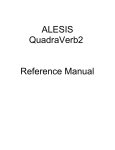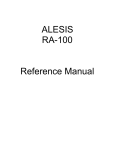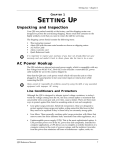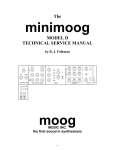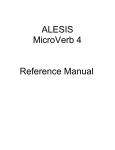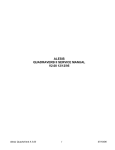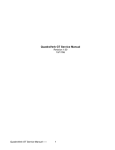Download Alesis QUADRAVERB Instruction manual
Transcript
Setting Up - Chapter 1 CHAPTER 1 SETTING UP Unpacking and Inspection Your QuadraVerb 2 was packed carefully at the factory, and the shipping carton was designed to protect the unit during shipping. Please retain this container in the highly unlikely event that you need to return the QuadraVerb 2 for servicing. The shipping carton should contain the following items: • • • • J This instruction manual Alesis QuadraVerb 2 with the same serial number as shown on shipping carton AC Power Supply Adapter Alesis warranty card It is important to register your purchase; if you have not already filled out your warranty card and mailed it back to Alesis, please take the time to do so now. AC Power Hookup The QuadraVerb 2 comes with a power adapter suitable for the voltage of the country it is shipped to (either 110 or 220V, 50 or 60 Hz). With the QuadraVerb 2 off, plug the small end of the power adapter cord into QuadraVerb 2’s [POWER] socket and the male (plug) end into a source of AC power. It’s good practice to not turn the QuadraVerb 2 on until all other cables are hooked up. J Alesis cannot be responsible for problems caused by using the QuadraVerb 2 or any associated equipment with improper AC wiring. Line Conditioners and Protectors Although the QuadraVerb 2 is designed to tolerate typical voltage variations, in today’s world the voltage coming from the AC line may contain spikes or transients that can possibly stress your gear and, over time, cause a failure. There are three main ways to protect against this, listed in ascending order of cost and complexity: • Line spike/surge protectors. Relatively inexpensive, these are designed to protect against strong surges and spikes, acting somewhat like fuses in that they need to be replaced if they’ve been hit by an extremely strong spike. • Line filters. These generally combine spike/surge protection with filters that remove some line noise (dimmer hash, transients from other appliances, etc.). • Uninterruptible power supply (UPS). This is the most sophisticated option. A UPS provides power even if the AC power line fails completely. Intended for computer applications, a UPS allows you to complete an orderly shutdown of a computer system in the event of a power outage, and the isolation it provides from the power line minimizes all forms of interference—spikes, noise, etc. Audio Connections The connections between the QuadraVerb 2 and your studio are your music’s lifeline, so use only high quality cables. These should be low-capacitance shielded cables with a stranded (not solid) internal conductor and a low-resistance shield. Although QuadraVerb 2 Reference Manual 7 Chapter 1 - Setting Up quality cables cost more, they do make a difference. Route cables to the QuadraVerb 2 correctly by observing the following precautions: • Do not bundle audio cables with AC power cords. • Avoid running audio cables near sources of electromagnetic interference such as transformers, monitors, computers, etc. • Do not place cables where they can be stepped on. Stepping on a cable may not cause immediate damage, but it can compress the insulation between the center conductor and shield (degrading performance) or reduce the cable’s reliability. • Avoid twisting the cable or having it make sharp, right angle turns. • Never unplug a cable by pulling on the wire itself. Always unplug by firmly grasping the body of the plug and pulling directly outward. • Although Alesis does not endorse any specific product, chemicals such as Tweek and Cramolin, when applied to electrical connectors, are claimed to improve the electrical contact between connectors. Typical Applications The analog audio inputs and outputs are typically used in one of three ways: • from one or two effect/aux send outputs of a mixer, and out to the effect return inputs of the mixer; or, • from a line-level instrument (like a guitar or keyboard with either a mono or stereo output), and out to an amplifier or mixer input; or, • from the stereo buss outputs of a mixer to a mix-down tape machine or amplifier. When used with a mono source, the QuadraVerb is placed between the source and the mixer/amplifier. Although the source may be mono, both the [LEFT] and [RIGHT] outputs can be connected to the inputs of a mixer/amplifier if stereo processing effects are desired. Alternatively, you could use the INSERTS on your mixer to “patch in” only the left or right channel of the QuadraVerb 2. If using the effect sends of a mixer, you have the advantage of sending any of the mixer’s input channels to the QuadraVerb 2’s input(s), and have control over the level of each channel being sent. There are other combinations of input and outputs possible when you begin using the Alesis optical digital input and output. See the “Alesis Optical” section later in this chapter. For more information on interfacing with other digital audio equipment, see chapter 7. Interfacing Directly with Instruments J When connecting audio cables and/or turning power on and off, make sure that all devices in your system are turned off and the volume controls are turned down. The QuadraVerb 2 has two 1/4” balanced inputs and two 1/4” balanced outputs. These provide three different (analog) audio hookup options: • 8 Mono. Connect a cable to the [R] INPUT of the QuadraVerb 2 from a mono source, and another cable from the [R] OUTPUT of the QuadraVerb 2 to an amplification system or mixer input. QuadraVerb 2 Reference Manual Setting Up - Chapter 1 Instrument or Effect Send To Amplifier or Mixing Console Right Input Right Output TM • Mono In, Stereo Out. While still using a mono input, you could connect two cables to the [L] and [R] OUTPUTS of the QuadraVerb 2 to a stereo amplification system or two mixer inputs. Instrument or Effect Send To Amplifier or Mixing Console Right Input Right Output Left Output TM • Dual Mono or Stereo Source. The QuadraVerb 2 may be used with two different instruments simultaneously, or with a stereo instrument. The hookup is the same; the difference is in the routing used within a program. A program may process the two inputs discretely, using blocks dedicated to a single channel (for example, a delay for a guitar and a gated reverb for a bass), or process them in stereo (for example, with the left and right outputs of a keyboard routed through two reverb blocks). Connect two cables to the [L] and [R] INPUTS of the QuadraVerb 2 from two mono sources or from the stereo output of the instrument, then connect two other cables from the [L] and [R] OUTPUTS of the QuadraVerb 2 to a stereo amplification system or two mixer inputs. To Amplifier or Mixing Console Instrument or Effect Send Left Input Right Input Right Output Left Output BLOCK TM 2 7 Note: In most cases when plugging an instrument directly into the QuadraVerb 2 , you’ll use Programs which route the "dry" signal at the input(s) directly to the output(s), where it will be mixed together with the effected signal to achieve the proper wet/dry mix at the QuadraVerb 2's outputs. If the program doesn't include this routing, you will only hear the effected signal by itself. Therefore, it may be necessary to edit such programs to add these "dry" routes when using the QuadraVerb 2 directly with an instrument. (The Factory Preset programs usually include these routes.) Interfacing to a Mixing Console The QuadraVerb 2 handles mono or stereo sends at all system levels. The input circuitry of the QuadraVerb 2 can easily handle +4 dBu levels (+19 dBu peaks), while having enough input and output gain to interface with the lower -10 dBV signal levels of many recording systems. QuadraVerb 2 Reference Manual 9 Chapter 1 - Setting Up The QuadraVerb 2 may be connected to a mixing console in several ways. Usually, it is connected to the auxiliary send and return controls of the mixer. Another method of interfacing is to connect the unit directly to the insert send and return patch points of the channel that is to be effected. Still another way of interfacing the QuadraVerb 2 to a mixer or recording console would be in-line across the output of your mixing console. This last setup would be used only if you needed to effect the entire mix. Using the Aux Sends Generally, mixing consoles provide two types of auxiliary sends: pre-fader sends for creating a cue (headphone) mix, and individual, post-fader effect sends. Typically, if a mixer has more than two sends per channel (4, 6 or 8, perhaps), the first two sends are reserved for the cue sends, while the remaining sends are used to feed effects. If you are using a mixer with more than two sends, connect the QuadraVerb 2 using post-fader sends. Using a mixer’s aux sends poses a distinct advantage: each channel has its own level control feeding the aux output (and eventually the QuadraVerb 2 input). This allows you to make a mix of any channels you want to go to the effects by using the individual channels’ aux send levels on the mixer. Most consoles also have aux master controls, which set the overall level of each aux output. Coming back from the QuadraVerb 2’s outputs into the mixer, you have two options: • connecting to dedicated return inputs, or • connecting to channel inputs. The former is good if your mixer provides dedicated inputs (called returns) for effect devices like the QuadraVerb 2. If your mixer does not have these, or you have already used them all, consider connecting the QuadraVerb 2 to channel inputs or unused tape returns. Setting the Effect/Dry Balance No matter where you connect the output of the QuadraVerb 2 into the mixer, you are in control of the balance between the mixer’s channel inputs (the uneffected signal being routed to the aux sends and the Mix) and the effect returns coming from the QuadraVerb 2. The effect returns generally should only contain effected signal, and not have any uneffected signal mixed with it (since these two signals are blended together at the mixer). If the Program you are using has the LR IN connected to the LR OUT, you may be getting some dry, uneffected signal at the return. Generally, this is not desirable, since the "dry" signal is already being heard through the original channel’s fader. Therefore, in a mixer application you will want to cut the QuadraVerb 2’s Program’s path which connects the inputs to the outputs. This can be done in three ways: 10 • Go to the Mix parameters to bring down the direct level • Go to the Routing function of each program and remove the patch cords connecting the inputs to the outputs • Turn on the Global Direct Signal Mute function. This is the easiest method. QuadraVerb 2 Reference Manual Setting Up - Chapter 1 J Most Preset Programs route the LR IN signal to the LR OUT.When connecting to a mixer’s aux sends and returns. the Global Direct Signal Mute should be set to ON. To remove all direct routings of inputs to outputs on all Programs simultaneously: ¿ Press [GLOBAL]. The [GLOBAL] LED will be lit. ¡ Press [< PAGE] once. This selects Global Page 9. The display will read: GLOBAL DIRECT SIGNAL MUTE: OFF ¬ Turn the [VALUE/ENTER] knob to the right until the display reads “ON.” The next Program recalled which has the inputs routed to the outputs will not display the patch cords for these connections nor will you hear any direct uneffected signal at the outputs. QuadraVerb 2 Reference Manual 11 Chapter 1 - Setting Up Mono In - Stereo Out. If you only want to feed the QuadraVerb 2 a mono input, but wish to connect both of its outputs back to the mixer, you will need three 1/4" audio cables. Connect a cable from an effect send to the [R] INPUT of the QuadraVerb 2, another cable from the [L] OUTPUT of the QuadraVerb 2 to an effect return or other mixer input, and another cable from the [R] OUTPUT of the QuadraVerb 2 to an adjacent mixer input. Right Input Left Output Right Output Aux Send 1 Aux Return or Input Channel Aux Return or Input Channel Mixer Stereo In - Stereo Out. This connection is similar to the one described above. However, by utilizing two sends from the mixer, we add one more cord and can now send a stereo signal to the QuadraVerb 2’s inputs. Example, if you connected effect sends 3 and 4 to the [L] and [R] INPUTS, and had a stereo instrument (such as a keyboard) connected to two channel inputs of the mixer (either one panned hard left and hard right), you would send the left channel to send 3 and the right channel to send 4. Alternatively, you could have two discrete effect sends between the Left and Right channel, and process each separately within the QuadraVerb 2. For example, the Left channel (from send 3) could be a chorus, and the Right (from send 4) could be a reverb. This is similar to Dual Mono, described earlier. Right Input Left Input Left Output Aux Send 3 Right Output Aux Send 4 Aux Return or Input Channel Aux Return or Input Channel Mixer Using Inserts By using individual channel inserts, you can dedicate the QuadraVerb 2 to a specific channel (or pair of channels) on the mixer. The Insert connections on the back of the mixer provide a way of “inserting” external processing equipment into the signal path. The insert occurs after the input amplifier, and before the main fader; essentially it is the same as connecting the source (instrument or microphone) into the QuadraVerb 2 before the mixer’s channel input. However, some mixing console’s inserts come after the EQ section, and may therefore be different from the original signal. 12 QuadraVerb 2 Reference Manual Setting Up - Chapter 1 Usually, insert connections require a special, stereo-splitting Y-cord to be connected (one stereo plug provides both send and return while two mono plugs connect separately to an input and output). These are known as TRS connectors (tip-ringsleeve). The tip of the stereo plug typically carries the send or output of the insert jack, while the ring carries back the return. The sleeve represents a common ground for both signals. Check the manual of your mixer because some are wired differently (for example, having two separate jacks for send and receive). Mono. This involves connecting a 1/4" TRS (tip-ring-sleeve) to the Insert jack of a single channel on a mixing console. The other end of the cable (which splits into two, 1/4" mono connectors) are connected to the [R] INPUT and [R] OUTPUT, respectively. If you do not hear any audio after making these connections, swap the input and output cables at the QuadraVerb 2, as these may be wired backwards. If the cable is color-coded, usually the red jack represents the send (which connects to the QuadraVerb 2’s INPUT) and black is the return (which connects to the OUTPUT). MIXER Insert Right Input Right Output 3 QuadraVerb 2 Reference Manual 13 Chapter 1 - Setting Up Stereo. In the case where a stereo instrument, such as a keyboard or sampler, is connected to two separate channels of a mixing console, you will need two 1/4" TRS cables, one for each channel. The connection is made in a similar fashion as described above. MIXER Right Master Insert Left Master Insert Left Input Left Output Right Input Right Output Using Main Outputs When you want to effect everything on the mixer, you can connect the QuadraVerb 2 between the mixer’s outputs and the amplifier’s or tape machine’s inputs. This is done by using two 1/4" cables to connect the Left and Right Main Outputs of the mixing console to the [L] and [R] INPUTs of the QuadraVerb 2. The [L] and [R] OUTPUTs of the QuadraVerb 2 are then connected to a stereo amplifier, or two input channels of another mixing console (for sub-mixing applications). Right Input Left Input Left Master Out Left Output Right Output Left Input Right Input Right Master Out Mixer Stereo Amp If your mixer’s outputs use XLR balanced connectors, use the illustration below as a guide for wiring cables to connect to the QuadraVerb 2’s inputs. 14 QuadraVerb 2 Reference Manual Setting Up - Chapter 1 Tip 2 1 Sleeve 3 Ring Avoiding Ground Loops In today’s studio, where it seems every piece of equipment has its own computer chip inside, there are many opportunities for ground loop problems to occur. These show up as hums, buzzes or sometimes radio reception, and can occur if a piece of equipment “sees” two or more different paths to ground. While there are methods to virtually eliminate ground loops and stray radio frequency interference, most of the professional methods are expensive and involve installing a separate power source just for the sound system. Here are some easy helpful hints that a professional studio installer might use to keep those stray hums and buzzes to a minimum. ¿ KEEP ALL ELECTRONICS OF THE SOUND SYSTEM ON THE SAME AC ELECTRICAL CIRCUIT. Most stray hums and buzzes happen as a result of different parts of the sound system being plugged into outlets of different AC circuits. If any noise generating devices such as air conditioners, refrigerators, neon lights, etc., are already plugged into one of these circuits, you then have a perfect condition for stray buzzes. Since most electronic devices of a sound system don’t require a lot of current (except power amplifiers), it’s usually safe to run a multi-outlet box (or two) from a SINGLE wall outlet, and plug in all of the components of your system there. ¡ KEEP AUDIO WIRING AS FAR AWAY FROM AC WIRING AS POSSIBLE. Many hums come from audio cabling being too near AC wiring. If a hum occurs, try moving the audio wiring around to see if the hum ceases or diminishes. If it’s not possible to separate the audio and AC wiring in some instances, make sure that the audio wires don’t run parallel to any AC wire (they should only cross at right angles, if possible). ¬ TO ELIMINATE HUM IF THE ABOVE HAS FAILED: A) Disconnect the power from all outboard devices and tape machines except for the mixer and control room monitor power amp. B) Plug in each tape machine and outboard effects device one at a time. If possible, flip the polarity of the plug of each device (turn it around in the socket) until the quietest position is found. C) Make sure that all of the audio cables are in good working order. Cables with a detached ground wire will cause a very loud hum!! D) Keep all cables as short as possible, especially in unbalanced circuits. If the basic experiments don’t uncover the source of the problem, consult your dealer or technician trained in proper studio grounding techniques. In some cases, a “star grounding” scheme must be used, with the mixer at the center of the star providing the shield ground on telescoping shields, which do NOT connect to the chassis ground of other equipment in the system. MIDI MIDI is an internationally-accepted protocol that allows music-related data to be conveyed from one device to another. The MIDI connections on the QuadraVerb 2 provide four different functions: QuadraVerb 2 Reference Manual 15 Chapter 1 - Setting Up • To recall programs using MIDI program change messages • To control various parameters inside the QuadraVerb 2 in realtime via MIDI controllers (example: A keyboard’s mod wheel, or pedals, etc.) • To send and receive SysEx (System Exclusive) dumps of individual programs or the entire bank of programs for storage and retrieval purposes • To pass-on MIDI information thru the QuadraVerb 2 to another MIDI device. To connect the QuadraVerb 2’s MIDI ports to another MIDI device: ¿ Connect a MIDI cable from the QuadraVerb 2’s MIDI [THRU/OUT] connector to the MIDI IN connector of the other MIDI device. ¡ Connect another MIDI cable from the QuadraVerb 2’s MIDI [IN] connector to the other MIDI device’s MIDI OUT connector. For more information about MIDI, refer to chapter 6. Alesis Optical The Alesis Optical interface provides two EIAJ fiber optic connectors for [DIG IN] and [DIG OUT]. These connectors use a proprietary Alesis multichannel format first introduced with the ADAT Multitrack Recorder. The QuadraVerb 2 can send and/or receive digital audio directly to/from an ADAT (or other devices which use the same optical interface). Digital connections provide better fidelity than the analog inputs and outputs. The proprietary Alesis Optical format carries up to 8 audio channels on a single fiber optic cable. Since the QuadraVerb 2 has two channels (left and right), you may choose two of the incoming 8 channels for the QuadraVerb 2 to process. The QuadraVerb 2’s Left and Right Outputs can then be routed in the digital format using any two channels (they don’t have to be the same as the input channels). Fiber optic cables of various lengths are available from your Alesis dealer. The shorter the cable, the better. The OC cable is 5 meters long (16'4") and is the maximum length recommended. Footswitches On the rear panel you will find two footswitch jacks labeled [ADVANCE] and [BYPASS]. Any momentary single-pole/single-throw footswitch, normally open or normally closed, will work for the two footswitch functions. These should be plugged in prior to power-up so that the QuadraVerb 2 can configure itself for the type of footswitch being used. Advance The [ADVANCE] jack lets you scroll through the Programs in memory by advancing to the next higher numbered Program each time the connected footswitch is pressed. The QuadraVerb 2 will “wrap-around” whenever it reaches the end of available Programs and the Advance footswitch is pressed again. You can set a range of Programs to be used, thereby cutting off other Programs from being recalled in this manner. For example, if you set the range to be User 10 through User 24, only Programs within this range will be recalled using the Advance footswitch. If Program 24 is selected and the footswitch is pressed again, Program 10 is recalled. 16 QuadraVerb 2 Reference Manual Setting Up - Chapter 1 To adjust the Advance Footswitch’s set of Programs: ¿ Press [GLOBAL]. The [GLOBAL] LED will light. ¡ Press [PAGE >] once. This selects page 2, and the display will read: FOOTSWITCH: 00 Pset TO 00 Pset ¬ Turn the [VALUE/ENTER] knob to adjust the Program number to begin the range (Preset 00 — 99, User 00 — 99). ÷ Press [PAGE >] once and use the [VALUE/ENTER] knob to adjust the Program number to end the range (Preset 00 — 99, User 00 — 99). Bypass The Bypass footswitch jack lets you turn the Bypass function on and off from a connected footswitch. When pressed, the [BYPASS] LED will light, indicating that Bypass mode is enabled. When pressed again, the [BYPASS] LED will turn off. For more information about Bypass mode, see chapters 2 and 5. Tap Tempo Either footswitch jack can be used to provide a tap tempo source for setting delay time, provided the selected Program uses one of the two available tap tempo delay types. This requires that you have defined an Effect Block as one of the two Tap Tempo delay types, and that the desired footswitch jack has been selected for controlling tap tempo. To select a footswitch jack for use with a Tap Tempo Delay: ¿ Press [GLOBAL]. The [GLOBAL] LED will light. ¡ Press [< PAGE] twice to select Global Page 8. The display will read: TAP TEMPO FOOTSWITCH: NONE ¬ Turn the [VALUE/ENTER] knob to select either the ADVANCE or BYPASS footswitch jack, depending on which one you wish to use to control tap tempo. QuadraVerb 2 Reference Manual 17











